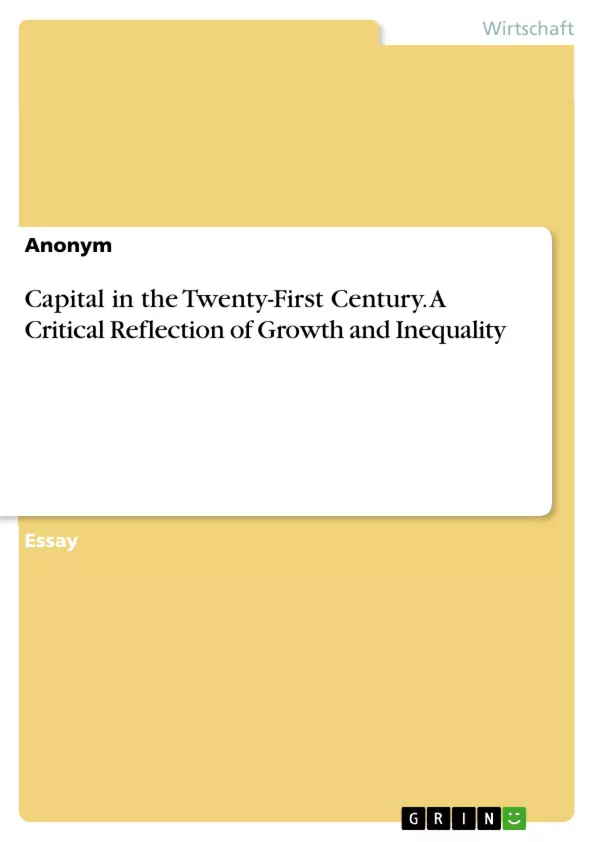The question of income and wealth inequality is not a mere economic question but also a political with a social dimension. The distribution is chaotic, unpredictable and can change rapidly under different institutional conditions. Nevertheless, growth and inequality are central components of capitalism, as there have always been profiteers and losers from the distribution issue. In contrast to other bestsellers, The Capital in the 21st Century written by Thomas Piketty is widely discussed because the book contributes a serious and discourse changing view on the question of inequality. Piketty caused a great stir, especially among conservatives, in the course of 2014 and sparked manifold discussions not only among economists, but also in a broader public. The book can be differentiated between its historical contribution as well as the extrapolation of the past in order to predict future developments concerning growth and inequality as well as implications for the institutions in the 21st century.
The aim of the following paper is therefore not to examine the historical correctness, but the general theoretical approach as well as the political implications. Accordingly, Piketty’s explanations on growth and inequality are elaborated in chapter 2. Chapter 3 reflects "Capital in the 21st century" from the perspective of growth, while chapter 4 focuses on inequality. The paper concludes in chapter 5 with a summary of Piketty’s arguments and a selection of counterarguments. Furthermore, limitations and an outlook are discussed.
Inhaltsverzeichnis
- Introduction
- A Brief Introduction to the General Laws of Capitalism
- Aim and Structure of the Paper
- A Brief Introduction to Capital in the 21st Century
- Introduction
- The Role of Growth in Capital in the 21st Century
- The Forces of Divergence
- The Forces of Convergence
- Limitations of Growth
- The Role of Inequality in Capital in the 21st Century
- An economic policy for the 21st century
- Main Arguments against the Understanding of Growth
- Criticism of r - g as the main force of injustice
- Criticism of the First Fundamental Law of Capitalism
- Criticism of The Second Fundamental Law of Capitalism
- Criticism of the Main Forces of Convergence
- Main Arguments against the Understanding of Inequality
- The role of institutions
- The role of labor market dynamics and innovation
- The role of social mobility and redistribution preferences
- The converging living standards argument
- Implications of Piketty’s political suggestions
- Selected impacts of inequality on the individual utility function
Zielsetzung und Themenschwerpunkte
Die vorliegende Arbeit analysiert Thomas Piketty’s Buch "Kapital im 21. Jahrhundert", welches eine umfassende Untersuchung des Verhältnisses zwischen Wachstum und Ungleichheit in der modernen kapitalistischen Wirtschaft bietet. Die Arbeit untersucht die Kernaussagen des Buches und setzt diese in Beziehung zu verschiedenen ökonomischen Theorien. Sie beleuchtet sowohl die Stärken als auch die Schwächen von Piketty’s Argumentation und diskutiert kritisch seine Vorschläge für eine gerechtere Gesellschaft.
- Die Bedeutung von Wachstum und Kapitalrendite für Ungleichheit
- Die zwei Grundgesetze des Kapitalismus nach Piketty
- Die Rolle von Institutionen und politischer Macht bei der Gestaltung von Ungleichheit
- Der Einfluss von technologischem Fortschritt, Arbeitsmarktdynamik und sozialer Mobilität auf die Einkommensverteilung
- Die Bedeutung von Umverteilungsmechanismen und den Präferenzen der Bevölkerung für soziale Mobilität
Zusammenfassung der Kapitel
- Kapitel 1: Einleitung
- Vorstellung der historischen Debatte über Wachstum und Ungleichheit im Kapitalismus, beginnend mit Ricardo und Marx.
- Erläuterung des Ziels und der Struktur der Arbeit, mit Fokus auf Piketty’s Argumentation und ausgewählte Gegenargumente.
- Kapitel 2: Kapital im 21. Jahrhundert
- Zusammenfassung von Piketty’s Argumentation, dass Ungleichheit ein zentrales Merkmal des Kapitalismus ist.
- Erläuterung der Rolle von Wachstum und Ungleichheit im Kapitalismus, insbesondere der Beziehung zwischen Kapitalrendite und Wachstum.
- Vorstellung der beiden Grundgesetze des Kapitalismus nach Piketty.
- Diskussion der Kräfte der Konvergenz und Divergenz in Bezug auf Einkommensungleichheit.
- Piketty’s Vorschläge für eine wirtschaftspolitische Intervention zur Begrenzung von Ungleichheit.
- Kapitel 3: Kritik an Piketty’s Sichtweise auf Wachstum
- Analyse der Kritik an Piketty’s Argumentation, dass die Ungleichheit zwischen Kapitalrendite und Wachstum die Hauptursache für Ungleichheit ist.
- Erläuterung der Gegenargumente, die auf Zeitpräferenzen, die abnehmende Kapitalrendite und die Rolle von Institutionen hinweisen.
- Diskussion der Bedeutung von technologischem Fortschritt und Innovationsfähigkeit für die Wirtschaft.
- Kapitel 4: Kritik an Piketty’s Sichtweise auf Ungleichheit
- Analyse der Bedeutung von Institutionen und politischer Macht für die Entstehung und Persistenz von Ungleichheit.
- Diskussion des Einflusses von Arbeitsmarktdynamik und Innovationen auf die Einkommensverteilung.
- Erläuterung der Beziehung zwischen sozialer Mobilität und Umverteilungspräferenzen.
- Bewertung der Argumentation, dass sich die Lebensstandards trotz zunehmender Einkommensungleichheit konvergieren.
- Kritik an Piketty’s politischen Vorschlägen, insbesondere in Bezug auf die Effekte von Steuern auf die Wirtschaft.
- Diskussion ausgewählter Auswirkungen von Ungleichheit auf die individuelle Nutzenfunktion.
Schlüsselwörter
Die Arbeit behandelt zentrale Themen wie Wachstum, Ungleichheit, Kapitalismus, Kapitalrendite, Institutionen, politische Macht, technologischer Fortschritt, Arbeitsmarktdynamik, soziale Mobilität, Umverteilung, Lebensstandards, und individuelle Nutzenfunktion. Sie konzentriert sich dabei auf die Analyse von Piketty’s Argumentation und die kritische Auseinandersetzung mit seinen Thesen und Schlussfolgerungen.
- Citation du texte
- Anonym (Auteur), 2019, Capital in the Twenty-First Century. A Critical Reflection of Growth and Inequality, Munich, GRIN Verlag, https://www.grin.com/document/1034395



